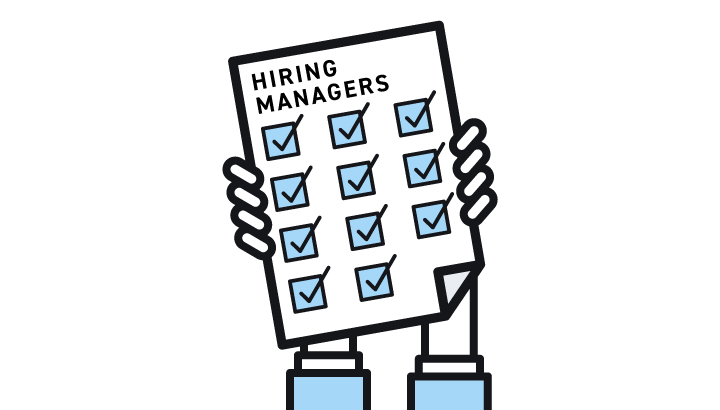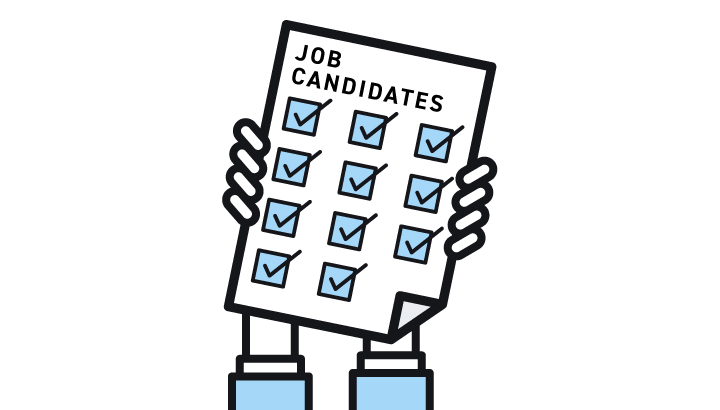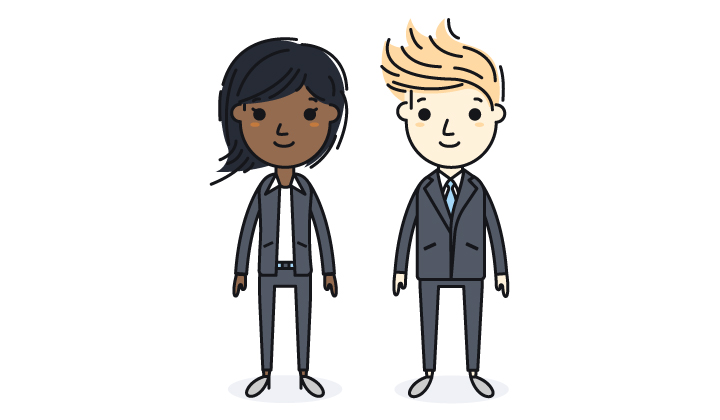You've landed an actual in-person interview? Congratulations! When it comes to the final stages of the employment process, the in-person job interview is a key step for both hiring teams and job seekers. But this necessary part of the hiring process produces anxiety in both the applicant and the interviewer.
If you’re interviewing on site, selling yourself and being grilled by strangers drains both time and energy. This is true for almost anyone, whether they’ve interviewed 10 times or just once.
For the interviewer, there’s a lot of pressure to find the right new hire. Failing to conduct a thorough on-site interview could lead to a bad hire. A bad hire could stymie productivity and undermine the culture in your organization.
Everyone has a lot riding on the in-person interview. That’s why we’ve assembled 22 suggestions for job seekers and Hiring Managers to help you ace that final round.
11 In-Person Interview Tips for Hiring Managers

A Hiring Manager has a challenging job with a lot riding on their ability to spot a good candidate. Considering that the average job opening attracts 250 resumes, the Hiring Manager must find a foolproof way to select the best candidate. That’s where the interview process comes in. Today, interviews can happen by video and certainly by phone, but it’s safe to assume that Hiring Managers prefer meeting candidates in person before making a decision about them. In many cases, the in-person interview is one of the final hurdles before the job is offered to someone.
Hiring teams should apply these best practices to every on-site interview:
1. Prepare for the interview. While this advice seems simplistic, we’ve all been in interviews where the hiring team seems disorganized, asks repeat questions, or obviously just saw the resume for the first time when they sat down. That’s exactly why we’re suggesting a basic level of preparedness that includes a review of the job responsibilities, candidate resume, and any prior interview notes. Try to take 20 minutes to a half hour before each candidate visits to assemble your notes and map out your questions.
2. Find a quiet spot where the candidate and the interviewers will feel comfortable and won’t be interrupted. Too many interviews start with trying to find an open conference room. If it looks and smells disorganized, it will leave a bad impression on the candidate. Interviews take planning and that planning should include the venue where the meeting will be held.
3. Explain the interview process and timeline to the candidate at the beginning of the interview. They should understand who they’re meeting with before the interview, but the interview lineup can change, so review it again. Make sure they understand the time commitment and the process of what happens after the interview. This is generally good to do with your hiring team in the room so everyone is on the same page.
4. Follow the rules for questions you can ask a candidate. Be sure your interview team also understands which questions are bad form or probably illegal. Most Hiring Managers are aware of the rules governing interview questions, but here are some links to the most important federal laws prohibiting discrimination during the hiring process:
- Title VII of the Civil Rights Act of 1964
- The Americans with Disabilities Act
- The Older Workers Benefit Protection Act
If you don’t have time to read the federal legislation, here are some of the most obviously verboten subjects you should not discuss during the interview process:
- Asking a candidate’s age
- Asking about their weight or physical health
- Asking if they are married
- Asking about their children (or if they have them)
- Asking if they prefer Mr., Miss, or Mrs
- Asking their political or religious affiliation
- Asking about their financial situation
Click here for a good list of both appropriate and illegal interview questions.

5. Ban phones from the in-person interview. While you may not be able to tell someone from the C-suite to turn off their phone, there are diplomatic ways to politely ask everyone to respect the interview process by giving their complete attention during the designated time. You can’t ban all digital devices if people like to take notes on their laptop or tablet, but you might consider designating one group scribe. If you have printed questions and a few minutes after the interview to decompress with the group, there really isn’t a need for everyone to have a digital device as a barrier between them and the candidate.
6. Listen more than you talk, because this interview isn’t about you. The truth is that most of us have been in interviews where the interviewer monopolized the conversation. If you are interviewing candidates as part of a team, do your best to address this issue with your team in advance. However, corporate politics or a lack of time before the interview may mean this isn’t something that the Hiring Manager can completely control.
7. Include a hiring team in the on-site interview. Sometimes, it takes a village, and that’s particularly true if you’re making a decision to hire. Hiring Managers should do their best to include department representation in the interview process. This is particularly important for cultural fit.
8. Ask behavioral questions to determine how candidates solve problems. Behavioral questions allow candidates to tell stories of their past actions that led to the overcoming of challenges or the achievement of their goals.
9. Trust your gut. Don’t discount intuition when it warns that something isn’t right. Take time to investigate the candidate a little more, even if you feel they need to come back for another on-site visit.
10. Be engaging and warm with the candidate, because in today’s low unemployment market, the candidate is also interviewing you. Treat the candidate interview like a visit to your house. Greet the candidate warmly at the door and invite them in to meet the team. Offer them some water or coffee and get them settled in comfortably. You should also consider a short tour of the facility, so they can start to envision themselves as part of your team. No matter what the hiring decision, this will promote a positive image of your team.
11. Leave time between interviews to decompress with your team. Make sure someone on the team is taking notes as you talk through what the team thought and felt about the candidate. While it may be tempting to schedule candidates back to back in a flurry of interviews, it is the time between the interviews that will allow you to reflect on what just happened. If you wait until the end of the day to go over all of the candidates you’ve seen, you’ll forget details or mix them up.
As an added bonus, be careful to treat each candidate fairly by asking them the same interview questions, and make sure your interviews run on schedule in order to avoid annoying everyone involved.
11 Interview Tips for Job Candidates

You did it. You tidied up your resume, made it through the first series of interviews by video and/or phone, and perhaps even did some skills testing. Congratulations! Now you’re in the final round of interviews and that includes an on-site visit. Did you know that only 2% of job candidates actually make it this far? It doesn’t matter if the final on-site interview goes south—you obviously have some skills. Your next task is to focus on meeting the team in person and making sure your questions are adequately answered so you can pick the right job.
Here are some tips for preparing and conducting a great face-to-face interview while also taking control of the process:
1. Research the interview team for some possible icebreakers to disarm and perhaps charm them. Try to come up with a few questions based on their profiles. Look at their LinkedIn profiles to see where they went to school or if they’ve been published recently. What do you have in common? How long have they been with the company? Taking the time to do some creative reconnaissance may help you feel less intimidated during the interview process by taking away the fear of the unknown.
2. Practice for the interview by asking someone you know to conduct a mock in-person interview. Try researching common interview questions in your field. Then speak your answers out loud while recording the fake interview. Did you sound confident? Are there any words you used that made you seem unappealing? How genuine did you sound? Did you come across as crisply professional or sloppy?
3. Ask about the interview format before arriving on-site. Will you interview with multiple people? How long with the interview take? Will you shadow someone in the department? Some jobs do on-site skills testing before the interview. For example, Developers are often required to take a coding test before being offered a job. Copywriters and Editors may need to take a writing skills test. Some interviewers like to take their candidates to lunch. No matter the format, make sure you find out what to expect in advance.
4. Talk to current employees at the company, if possible, before the interview. Be careful in doing this because every interaction you have could carry weight for or against your candidacy. Start with LinkedIn and see if you are connected with any current employees. See if they would be willing to chat by phone, go out for coffee, or just respond via email. Ask them about corporate culture and if they have any advice for you as a potential employee. Of course, check Glassdoor to see what people are saying online.

5. Dress up even when it’s a casual dress code. It’s always better to look better. Psychology Today points out that humans are visual creatures. This means we still make snap judgments that typically rate people better or worse than they really are - on everything from a portfolio to interview attire. This tendency to judge based on looks alone is the best argument for looking as sharp as possible during the on-site interview. While we know there are a host of innovative start-up environments out there that embrace the Hawaiian shirt and cargo shorts, save that outfit for your first (or fifth) day on the job.
6. Know how you’ll address any red flags in your resume. For example, is there a job gap somewhere that you’ll need to explain? Did you stay at a past job for less than a year? You may be asked if you’ve ever resigned or been fired. People quit their jobs for all kinds of reasons. You can also be let go through no fault of your own. Be honest and carefully professional in your responses. Resist the urge to bad-mouth your former employer, even if the interviewer tries to get you to elaborate on a job that you fled from because your boss was difficult.
7. Ask questions during the interview—and these should include clarifying questions about the job duties or the interviewer’s questions. Many of your questions may have been answered during the series of interviews that probably led to your on-site visit, but you should still come prepared with questions about culture and what the day-to-day work will be like. We suggest reviewing common interview questions ahead of time. Here are some good questions to keep in your back pocket:
- What was the last team event the department participated in?
- What will be my biggest challenge in the first 30 days?
- How can I prepare for my first day on the job?
- Describe your culture in three words.
8. Consider your skills from the employer perspective. The employer is trying to figure out how your skills will help the company, so before the interview, look at the job description and think about how your unique set of experiences could benefit their team. Try to paint a picture of how your skills could fit both the position and their corporate goals.
9. Arrive early. While this seems obvious, you would be amazed at how many people arrive a few minutes (or more) late to an interview. Make sure you bring physical copies of your resume and references for everyone you’ll interview with.
10. Share your enthusiasm for the position. Your eagerness and interest in the job should shine from the cover letter to your acceptance. You want employers to know that you are engaged and ready to work from day one. You do not want interviewers to think you are uninterested in the position (at least, not until you turn it down).
11. Send a “thank you” email to all the members of the interview team. These old-school touches still matter to most interviewers. It doesn’t matter if the interview went poorly and you know that you either don’t want or won’t be offered the job. Taking the time to say thank you is always a classy move.
Attention Hiring Managers and Job Seekers: Artisan Talent is standing by to help, whether you’re seeking new talent or a new job. We can help you stay ahead of the candidate search and interview process, and help you reach your employment goals.



.gif?width=436&height=255&name=Red_Flags%20(1).gif)
/SocialMedia_alt.jpg?width=436&height=255&name=SocialMedia_alt.jpg)